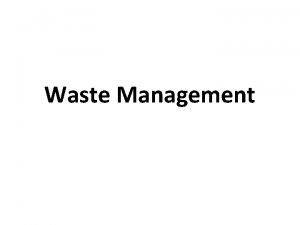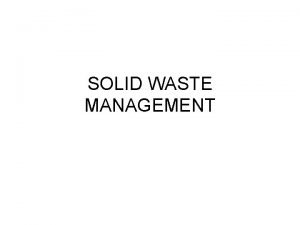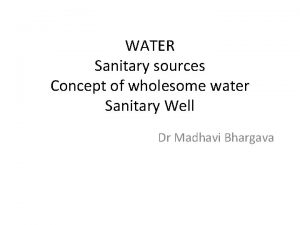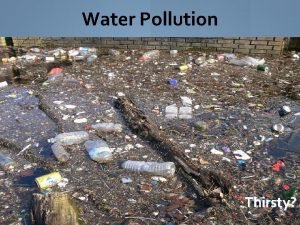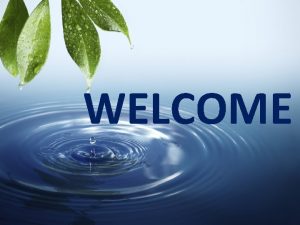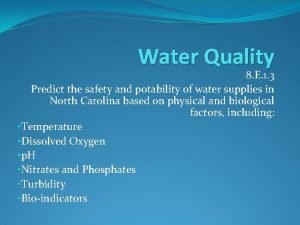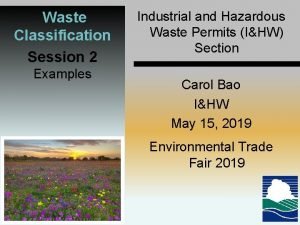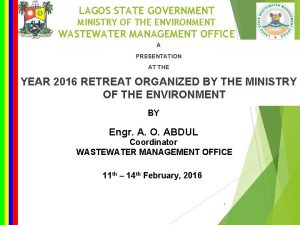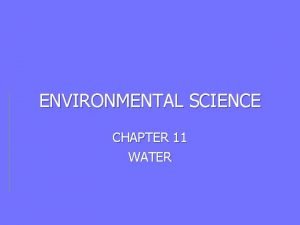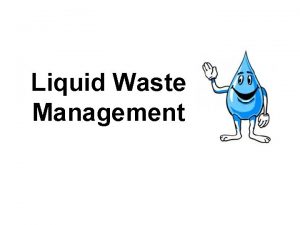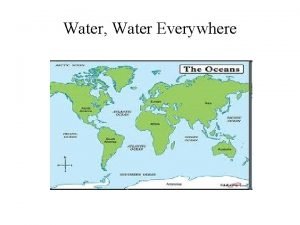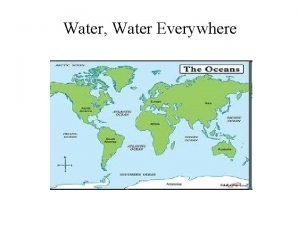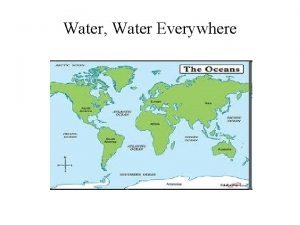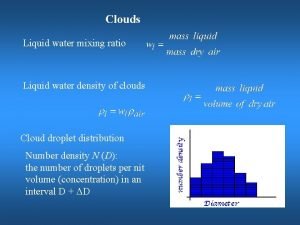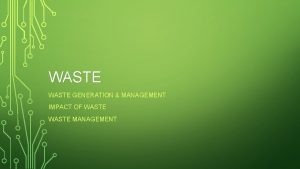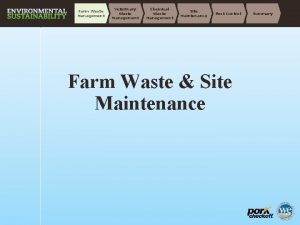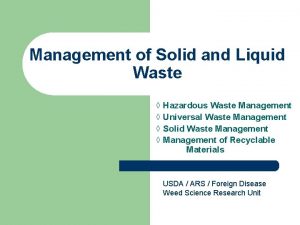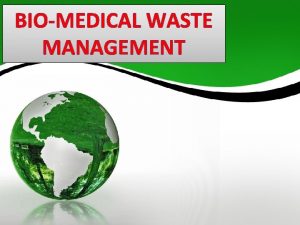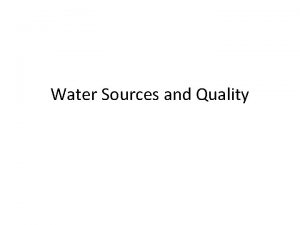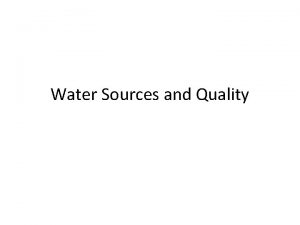Liquid WASTE WATER MANAGEMENT Sources of Liquid Waste















- Slides: 15

Liquid WASTE WATER MANAGEMENT

Sources of Liquid Waste Have you ever though about where liquids that flow from sinks, tubs, showers, and toilets go? Is it a sewer system or is it the environment?

What are we talking about here? Cooking oils, motor oils, products containing water like paints, cleaners, pesticides and fertilizers. Liquid wastes, with or without water are called WASTEWATER MUNICIPAL, AGRICULTURE, AND INDUSTRIAL

Diversity of Waste-Water Sources MUNICIPAL AGRICULTURAL INDUSTRIAL Sinks, tubs showers Contaminates surface and ground water with run off from fertilizers and pesticides Petroleum products Food, oils, Cleaners, Antibiotics and medications Paints, fertilizers, … Also nutrients, organic matter, and bacteria Can easily wash into nearby waterways Metals Nutrients Sediments Acids Many hazardous to human health

MUNICIPAL SOURCES Waste water from homes, businesses and schools as well as pavement and other urban surfaced Storm Water: • Rain, melting snow, that drains from diveways, roofs, lawns and roads • Liquid waste poured into storm drains • Sediments, organic matter, harmful chemicals Sewage: • Anything rinsed down a drain or flushed down a toilet • Mostly organic matter (urine, feces, food scraps, laundry and dish water • 100’s of other chemicals • Plasticixers • Medicines • Pestcides • Flame retardants

Chemicals can have significant impacts on Ecosystems About 85 percent of male smallmouth bass collected in national wildlife refuges in the Northeastern U. S. had eggs were growing in their testes. Pollutants that mimic sex hormones are the suspected culprit. PHOTOGRAPH BY JOEL SARTORE, NATIONAL GEOGRAPHIC PHOTO ARK

Treating Sewage Liquid waste Can NOT be disposed of in landfill - increases amount of leachate - structural instability Sewage MUST be treated before it is released into the environment

Treatment Depends on Where you Live RURAL SEPTIC SYSTEMS When land is available and population density is low 14% of Canadian homes in 2009 URBAN MUNICIPAL SEWAGE TREATMENT FACILITY Homes and other buildings in towns and cities are linked to municipal sewage treatment facilities through sanitary sewers

Septic Systems 1. waste water to septic tank ◦ Grease and oils rise ◦ Solids settle and decomposed by bacteria 2. clarified liquid channeled through a drain field 3. excess water wicked up and evaporates 4. solids are pumped out by tank truck periodically for treatment and disposal

Municipal Sewage Treatment Metro Vancouver collects and treats the region's wastewater. We operate five wastewater treatment plants, maintain a region-wide network of sewers and pumping stations, and conduct regular environmental monitoring to ensure that the system is working well. Our main goals are to protect public health and the environment, use wastewater as a resource and minimize treatment costs. HTTP: //WWW. METROVANCOUVER. ORG/SERVIC ES/LIQUID-WASTE/PAGES/DEFAULT. ASPX

Municipal Sewage Treatment PRIMARY TREATMENT SECONDARY TREATMENT Physically separated large solids from sewage Biological Breakdown of Dissolved Organic Compounds ◦ ◦ Metal grates remove large debris Screens filter smaller objects Grit tank = heavier particles settle Primary Sedimentation Tank – semi-solid material called sludge settles ◦ *** many bacteria remain at this point -bacteria are encouraged to break down the organic matter - disinfected with chlorine, IV light, or ozone to kill bacteria

http: //www. metrovancouver. org/services/liquidwaste/treatment-plants/how-wastewatertreated/Pages/default. aspx Metro Vancouver treats about 440 billion litres of wastewater (or sewage) every year. Wastewater can contain a number of different pollutants and waste products, including soap, food scraps, human waste, oils and other chemicals. Why we treat wastewater The goal of wastewater treatment is to protect and maintain healthy rivers and oceans. If pollutants in wastewater are not removed, they flow directly into our waterways. This can threaten public health, fisheries, wildlife habitat, recreation opportunities and ultimately, our quality of life.

Municipal Sewage Treatment TERTIARY TREATMENT - free of disease-causing bacteria and organisms - still contains nitrates, phosphates and other inorganic substances - pass through a natural wetland or chemical filtering system

Our Drinking Water Metro Vancouver owns and operates two modern world-class drinking water treatment facilities. Seymour-Capilano Filtration Plant (SCFP) Coquitlam Water Treatment Plant (CWTP) These facilities ensure our drinking water is clean, safe and high quality now and for future generations. Find out more in this two minute film clip. http: //www. metrovancouver. org/services/water/quality-facilities/facilities-processes/drinkingwater-treatment-facilities/Pages/default. aspx http: //www. metrovancouver. org/services/water/Water. Publications/SEYCap. Brochure. pdf

Global News – Nov 4 th 2019 https: //globalnews. ca/news/6114854/canada-tapwater-high-lead-levels-investigation/
 Importance water resources
Importance water resources Water and water and water water
Water and water and water water Print sources and web sources
Print sources and web sources What are wastes
What are wastes Waste is any material that is not needed by the owner
Waste is any material that is not needed by the owner Sources of waste
Sources of waste Platform of sanitary well
Platform of sanitary well Examples of point source pollution
Examples of point source pollution 10 sources of water
10 sources of water What is water
What is water Predict the sources of water
Predict the sources of water What is a listed waste
What is a listed waste Example of pure liquid dielectric is
Example of pure liquid dielectric is Liquid liquid extraction unit
Liquid liquid extraction unit Lagos waste water
Lagos waste water Water that contains waste from homes or industry.
Water that contains waste from homes or industry.



